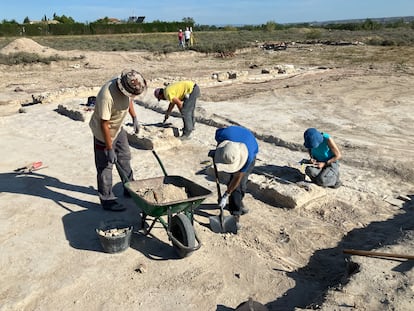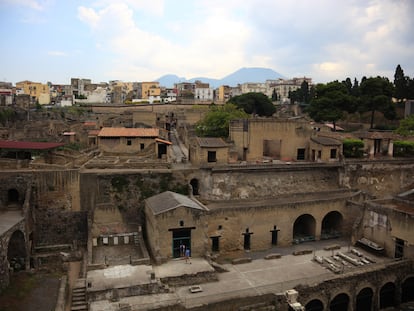The pioneer colony of the 4,000 free men of Hispania languishes between chimneys
Activists and experts demand greater resources for Carteia, in the province of Cádiz, Spain. The remains of a Roman town lie hidden among oil refineries but are essential to understand the history of the Iberian Peninsula
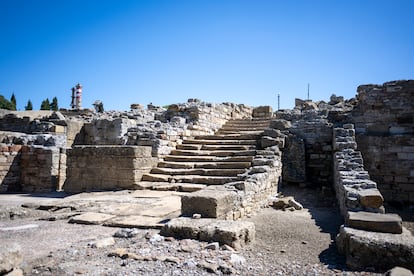
Back in 171 B.C. a delegation representing more than 4,000 men born to Roman soldiers and Hispanic women stood before the Roman Senate to demand their rights. The participants in the scene must have been so unique that the Roman historian Livy defined them as “a new species,” halfway to between full Roman citizens and not citizens at all. Although, in practice, they only asked for “a city to live in” and a plot of land. They were granted Carteia, an ancient Phoenician town on the Strait of Gibraltar, dating from the 7th century B.C. The concession made it the first Roman colony outside the territory of present-day Italy. But not even its importance in the history of Hispania could save it from its current fate: languishing behind the chimneys of a refinery.
Unlike the well-known Roman town of Baelo Claudia nearby, Carteia has been forsaken. But while the ruins of the Baelo Claudia are an archaeological complex today — with a museum, its own management and extensive visiting hours — Carteia is just an enclave that is managed by the Andalusian Agency for Cultural Institutions and does not even have a visitor center. It has limited openings — mornings from Wednesday to Sunday — and only seven workers to monitor the 27-hectare (66-acre) site. “It’s a shame, as an ancient city it is very important and from a heritage point of view, it is very interesting (…). It is a city from the [Iberian] Peninsula’s Roman past and that is clear to those involved in the world of research,” says Lourdes Roldán, professor of Ancient Art at the Autonomous University of Madrid.
The recent history of Carteia as a site is linked to the sociopolitical development of the Campo de Gibraltar and the development of the petrochemical hub that is a blot on the landscape of today. Although there is evidence of the existence of archaeological remains in the area at least since the 16th century, it was not until the 1950s and 1960s that they were excavated and had their boundaries defined. These works were essential for the construction of the San Roque refinery that borders the enclave. “Sealing the border [with Gibraltar, decreed by the Franco regime in 1969] led to these industries being set up and the deterioration of the entire environment. It is surrounded on three sides by the chimneys, and now it takes more effort to make the site more attractive,” recalls Margarita García, the site’s former coordinator.

The chimneys that loom over the site — which has the remains of a Punic wall, a Roman temple from the time of the Republic, a thermal building, several domus, and salting factories — are also an obstacle for the professor in Archeology from the University of Cádiz, Darío Bernal. “I have excavated the site for years, and you can see and smell the refinery. What’s more, it is a site that opened to the public later than others, and you have to travel to see it. It is also very big. The distances within the site are greater and that makes it more complex,” he says. Roldán, who has studied the remains for decades, provides more reasons for the apparent indifference that surrounds the place: “It’s unfortunate that not everything that has been done has been published, so it isn’t as well known on a scientific level. Nothing about the site had been published until we at the UAM started working on it in 1994.”
The work of Roldán’s team served to date the oldest vestiges of the then-Phoenician city to the 7th century B.C. It also helped to understand Carteia as “a strategic location that joined East and West, Europe and Africa. It was a place of transit and contact. The town’s economy was basically seafood, fishing, and salting,” adds the professor. The history of the Roman Empire also reserves its space for it, thanks to the fact that in the year 171 B.C. Carteia became the first colony under Roman law, outside of present-day Italy, after those sons of Roman soldiers and Hispanic women asked the Senate for a place to settle. But it turned out that the concession from Rome gave them a new status, as well as a home. “It does not imply that the inhabitants of Carteia were previously slaves, but rather that they were outside the Roman legal system. When the question was posed to the Senate, they found that the best formula was the one they already followed with the freed slaves,” explains Professor of Ancient History at the University of Cádiz Lázaro Lagóstena. The professor at the University of Cambridge and Princess of Asturias award winner Mary Beard went further and called the decision “revolutionary, because it established the principle that you could be a Roman citizen of some sort having anything to do with Rome and Italy itself,” as she stated when she visited the enclave in her BBC television series, Rome, an empire without limit.
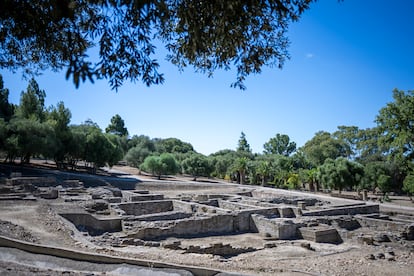
Already on that televised walk, Beard was surprised that, despite its importance, Carteia was a place that “you have to be pretty determined to find”: “I don’t think it’s on the main tourist beat.” Still, being cut off has had its phases. Margarita García became coordinator of the enclave between 2001 and 2007, in a period in which she was appointed by the commission and given the role to liaise between the Board’s Directorate of Cultural Assets and the City Council to improve the management of the enclave. They were good years to publicize a site that even has three bunkers built on it by the Franco regime during the Second World War, due to fear of an invasion by the Allies. But interest soon waned, and no one replaced García in her position, “neither the archaeologist nor the restorer” who once owned the site. “Today there is no team, there is no one in charge to promote the development of Carteia. That should be a joint effort between [local] administrations and all those industries that are there and whose location makes them responsible for Carteia not being Baelo,” the former coordinator complains.
But in the indifference that apparently suffocates the site, there was a straw that broke the camel’s back. Last March, a bureaucratic problem led to the space to being closed for several days, after the only guide was left without a contract. The Department of Culture of the Andalusian government sorted the mess out a few days later, but the torch of unrest was already lit. García joined social and environmental groups to demand a change in the administrative catalog so that the property would be listed as an archaeological complex. “The fundamental thing is its management. That cannot be administered by a provincial coordinator whose work center is spread over 120 kilometers,” says the activist. The group, which has already demonstrated at the gates of the enclave, even managed to get the Andalusian Parliament to pass a proposal in May to change the management of Carteia.
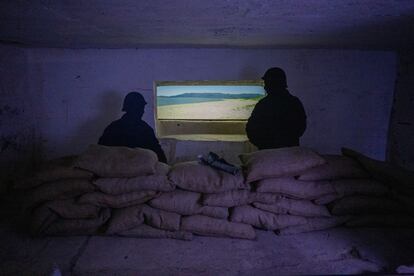
The Andalusian Ministry of Culture has said that “the change to an archaeological complex is being considered” and they closed ranks with the site by reminding the public that in April, regional minister Arturo Bernal visited the excavations that the University of Cádiz was carrying out, which were focused on the thriving salting industry that the Roman city had. There, the lawmaker limited himself to ensuring that the staff was “correctly trained.” But Professor Darío Bernal believes that “human resources are quite limited.” “It is a very important site, it is very well-preserved and archaeologically well understood. Any effort they make will be small. It should be a model site. The problem is that there is so much heritage in Andalusia that it is very difficult to maintain it all. It is not a cheap investment,” the archaeologist adds. But Margarita García has not lost hope and states: “It is time to take care of what industry has taken away.”
Sign up for our weekly newsletter to get more English-language news coverage from EL PAÍS USA Edition
Tu suscripción se está usando en otro dispositivo
¿Quieres añadir otro usuario a tu suscripción?
Si continúas leyendo en este dispositivo, no se podrá leer en el otro.
FlechaTu suscripción se está usando en otro dispositivo y solo puedes acceder a EL PAÍS desde un dispositivo a la vez.
Si quieres compartir tu cuenta, cambia tu suscripción a la modalidad Premium, así podrás añadir otro usuario. Cada uno accederá con su propia cuenta de email, lo que os permitirá personalizar vuestra experiencia en EL PAÍS.
¿Tienes una suscripción de empresa? Accede aquí para contratar más cuentas.
En el caso de no saber quién está usando tu cuenta, te recomendamos cambiar tu contraseña aquí.
Si decides continuar compartiendo tu cuenta, este mensaje se mostrará en tu dispositivo y en el de la otra persona que está usando tu cuenta de forma indefinida, afectando a tu experiencia de lectura. Puedes consultar aquí los términos y condiciones de la suscripción digital.
More information
Archived In
Últimas noticias
There is as much life left to discover on planet Earth as that which is already known
Dozens presumed dead, around 100 injured in fire at Swiss Alps bar during New Year’s celebration
Is porn for women different from conventional porn? We spoke to those who make it
Cartagena de Indias is sinking: What can the city do to mitigate it?
Most viewed
- Reinhard Genzel, Nobel laureate in physics: ‘One-minute videos will never give you the truth’
- David King, chemist: ‘There are scientists studying how to cool the planet; nobody should stop these experiments from happening’
- Oona Chaplin: ‘I told James Cameron that I was living in a treehouse and starting a permaculture project with a friend’
- Sinaloa Cartel war is taking its toll on Los Chapitos
- The Interoceanic Train, the Mexican alternative to the Panama Canal

